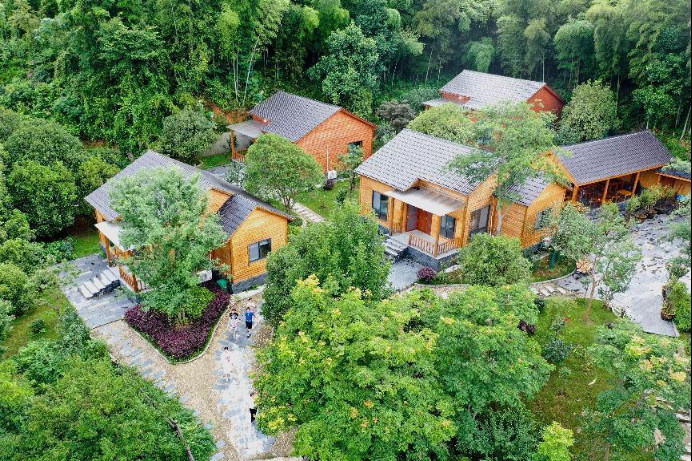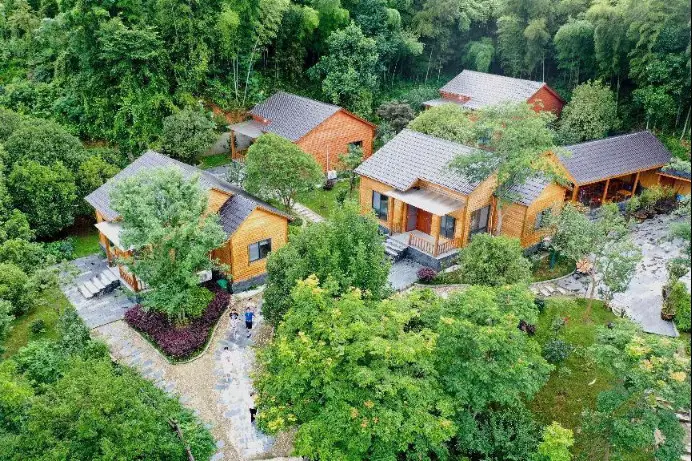By Qiang Wei, People's Daily

Photo shows a B&B hotel converted from rural houses in Nonglin village, Xihu township, Tongguan district, Tongling, east China's Anhui Province. (Photo by Guo Shining/People's Daily Online)
With snow on the grey tiled roof and red lanterns strung on the porch, every house in Zhanghe village, Lingchuan county, Jincheng, north China's Shanxi province had already been immersed in a festive atmosphere before the 2023 Spring Festival, or the 2023 Chinese Lunar New Year.
Wang Chuan, a villager of Zhanghe village, was busy preparing his B&B hotel for the coming holiday.
"Many regulars have spent New Year's Eve and enjoyed the reunion dinner here in my house for several years. The meat prepared used up quickly, and I need to go to the town to buy some more," Wang told People's Daily.
Zhanghe village used to be an important transportation hub of ancient trade routes, and has retained many features and folk customs of traditional villages in northern China. The village has vigorously developed characteristic tourism leveraging its cultural traditions in recent years.
Motivated by the positive changes in his hometown, Wang, who has worked as a cook for years, decided to return to the village with his wife to start their own business.
Their old house was invested in and transformed into a B&B hotel, which has enjoyed booming business. Wang no longer has to leave his hometown for employment.
The development of Zhanghe village is an epitome of the industrial upgrading achieved through transformation and investment in many villages of the country in recent years. The practice has given villages brand new looks, attracting more and more migrant workers back home.
It's estimated that the per capita annual income of Zhanghe village will exceed 30,000 yuan ($4,383.27) by 2025.
At present, nearly 510 million people live in rural areas of China, accounting for 36.11 percent of the country's total population. Since farmers constitute the main part of China's low-income earners, the well-off life of farmers is important for the country to achieve its goal of common prosperity.
In Wenzhou, east China's Zhejiang province, "city study rooms", 24-hour self-service public libraries, have enjoyed growing popularity among readers.
These libraries provide free, equal, and barrier-free services for readers, representing a vivid practice of Wenzhou's efforts to achieve common prosperity in the pursuit of spiritual development.
The city has established 136 "city study rooms" since the first one opened to the public in 2014, with a combined area of more than 34,800 square meters and a total collection of nearly 1.43 million volumes. These libraries have received more than 15.06 million visits and witnessed the circulation of over 14.8 million volumes of books.
"Unlike traditional libraries or bookstores, 'city study rooms' usually have a cozy and beautiful environment, making people feel at home," a student surnamed Chen told People's Daily in a "city study room" on Nantang Street in Wenzhou.
"At first I just came in to shelter from the rain, and I didn't expect to find an amazing 'new world' here. Now I'm a big fan of the place," Chen said.
China has become the second-largest economy in the world. In 2022, the country's gross domestic product (GDP) surpassed 120 trillion yuan, which was equivalent to about $18 trillion based on the average annual exchange rate.
Meanwhile, China's per capita GDP is only $12,700, which is still a long way from reaching the level of medium-developed countries.
Continuously promoting the material and spiritual civilizations for the people on the path to common prosperity is an important feature of Chinese modernization and a direction of China's development.
Chinese modernization offers a new choice for achieving modernization.
"The amount of disruption brought about by technology, together with the impact of the COVID-19 pandemic, has exacerbated the already serious income and wealth gaps, highlighting the urgent need to promote inclusiveness and common prosperity within the global sphere," pointed out an article published on the website of International Institute for Management Development, a think tank in Switzerland.
China's promotion of common prosperity contributes "Chinese wisdom and solutions to the important challenges of human development worldwide," according to the article.
"For China to embrace common prosperity, to establish a society of greater fairness, greater equity, that is a very important message not only to China, Chinese people but to the world as well," British scholar and political commentator Martin Jacques said.
As China marches toward modernization, it will bring more opportunities to the world, inject stronger momentum for international cooperation, and make greater contributions to human progress.
This year marks the 10th anniversary of the China-proposed Belt and Road Initiative (BRI). So far, China has signed BRI cooperation documents with a total of 151 countries.
By the end of 2022, Chinese companies had invested 397.9 billion yuan in the cooperation zones in countries along the routes of the BRI, and created 421,000 local jobs. A World Bank report estimated that BRI-related investments could lift 7.6 million from extreme poverty and 32 million from moderate poverty by 2030.
The Global Development Initiative (GDI), a global public good China has offered to the world, has provided a roadmap for narrowing the North-South gap and addressing the imbalance in development, and accelerated the implementation of the UN 2030 Agenda for Sustainable Development.
Over the past more than a year since the initiative was proposed, more than 60 countries have joined the Group of Friends of the GDI.
As Chinese President Xi Jinping said, "On the road to the wellbeing of all mankind, no country or nation should be left behind."
The concept and practice of Chinese modernization have continuously injected new connotations and impetus into the building of a community with a shared future for mankind, pointed out the way forward for human civilization, and opened up broader prospects for the common development of humanity.
Wang Chuan, a villager of Zhanghe village, was busy preparing his B&B hotel for the coming holiday.
"Many regulars have spent New Year's Eve and enjoyed the reunion dinner here in my house for several years. The meat prepared used up quickly, and I need to go to the town to buy some more," Wang told People's Daily.
Zhanghe village used to be an important transportation hub of ancient trade routes, and has retained many features and folk customs of traditional villages in northern China. The village has vigorously developed characteristic tourism leveraging its cultural traditions in recent years.
Motivated by the positive changes in his hometown, Wang, who has worked as a cook for years, decided to return to the village with his wife to start their own business.
Their old house was invested in and transformed into a B&B hotel, which has enjoyed booming business. Wang no longer has to leave his hometown for employment.
The development of Zhanghe village is an epitome of the industrial upgrading achieved through transformation and investment in many villages of the country in recent years. The practice has given villages brand new looks, attracting more and more migrant workers back home.
It's estimated that the per capita annual income of Zhanghe village will exceed 30,000 yuan ($4,383.27) by 2025.
At present, nearly 510 million people live in rural areas of China, accounting for 36.11 percent of the country's total population. Since farmers constitute the main part of China's low-income earners, the well-off life of farmers is important for the country to achieve its goal of common prosperity.
In Wenzhou, east China's Zhejiang province, "city study rooms", 24-hour self-service public libraries, have enjoyed growing popularity among readers.
These libraries provide free, equal, and barrier-free services for readers, representing a vivid practice of Wenzhou's efforts to achieve common prosperity in the pursuit of spiritual development.
The city has established 136 "city study rooms" since the first one opened to the public in 2014, with a combined area of more than 34,800 square meters and a total collection of nearly 1.43 million volumes. These libraries have received more than 15.06 million visits and witnessed the circulation of over 14.8 million volumes of books.
"Unlike traditional libraries or bookstores, 'city study rooms' usually have a cozy and beautiful environment, making people feel at home," a student surnamed Chen told People's Daily in a "city study room" on Nantang Street in Wenzhou.
"At first I just came in to shelter from the rain, and I didn't expect to find an amazing 'new world' here. Now I'm a big fan of the place," Chen said.
China has become the second-largest economy in the world. In 2022, the country's gross domestic product (GDP) surpassed 120 trillion yuan, which was equivalent to about $18 trillion based on the average annual exchange rate.
Meanwhile, China's per capita GDP is only $12,700, which is still a long way from reaching the level of medium-developed countries.
Continuously promoting the material and spiritual civilizations for the people on the path to common prosperity is an important feature of Chinese modernization and a direction of China's development.
Chinese modernization offers a new choice for achieving modernization.
"The amount of disruption brought about by technology, together with the impact of the COVID-19 pandemic, has exacerbated the already serious income and wealth gaps, highlighting the urgent need to promote inclusiveness and common prosperity within the global sphere," pointed out an article published on the website of International Institute for Management Development, a think tank in Switzerland.
China's promotion of common prosperity contributes "Chinese wisdom and solutions to the important challenges of human development worldwide," according to the article.
"For China to embrace common prosperity, to establish a society of greater fairness, greater equity, that is a very important message not only to China, Chinese people but to the world as well," British scholar and political commentator Martin Jacques said.
As China marches toward modernization, it will bring more opportunities to the world, inject stronger momentum for international cooperation, and make greater contributions to human progress.
This year marks the 10th anniversary of the China-proposed Belt and Road Initiative (BRI). So far, China has signed BRI cooperation documents with a total of 151 countries.
By the end of 2022, Chinese companies had invested 397.9 billion yuan in the cooperation zones in countries along the routes of the BRI, and created 421,000 local jobs. A World Bank report estimated that BRI-related investments could lift 7.6 million from extreme poverty and 32 million from moderate poverty by 2030.
The Global Development Initiative (GDI), a global public good China has offered to the world, has provided a roadmap for narrowing the North-South gap and addressing the imbalance in development, and accelerated the implementation of the UN 2030 Agenda for Sustainable Development.
Over the past more than a year since the initiative was proposed, more than 60 countries have joined the Group of Friends of the GDI.
As Chinese President Xi Jinping said, "On the road to the wellbeing of all mankind, no country or nation should be left behind."
The concept and practice of Chinese modernization have continuously injected new connotations and impetus into the building of a community with a shared future for mankind, pointed out the way forward for human civilization, and opened up broader prospects for the common development of humanity.
 Menu
Menu
 China's unswerving pursuit of common prosperity
China's unswerving pursuit of common prosperity
















